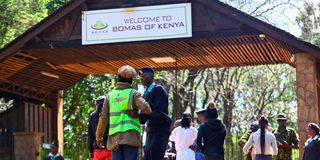
A security check point at the Bomas of Kenya during a public participation exercise on October 4, 2024.
There is no doubt that Kenya needs conference facilities that can compete with the best in the world. Meetings, Incentives, Conference and Exhibitions tourism is a major growth sector that has not been fully exploited in Kenya.
To that extent, the ongoing re-development of the Bomas of Kenya to include ultra-modern convention centres, performance theatres and five-star hotels might be a timely and visionary idea. However, this is a project should be suspended immediately pending resolution of some major issues. One is the opacity and secrecy surrounding the entire project.
As with most things the government wants to shield from public scrutiny and the usual oversight and audit mechanisms, it has been put under the Ministry of Defence, which in turn has been drawn into an untidy legal spat with a Turkish firm originally awarded the tender to construct and secure financing for the project at an estimated cost of Sh31 billion.
A statement released following a Cabinet meeting in mid-March signalled President William Ruto’s determination to proceed with the Bomas International Convention Complex, notwithstanding the fact that the matter was still tied up in court.
Cultural performances
Bomas has since suspended the usual activity of conferences and cultural performances as bulldozers descended on the site. And that is the first point of alarm. The iconic amphitheatre, which defined Bomas, is being brought down to make way for some “modern” concrete edifice. That is one facility that should be preserved as part of our rich cultural and architectural heritage. Bomas has enough land to accommodate new facilities without destroying what already exists.
There is also the very real possibility that what the government intends to construct, though reputedly ultra-modern, could be ugly and totally inconsistent with the environment in which it is being planted. We know that people in government have an outsize love for showcasing the biggest, tallest, grandest monstrosities, with little regard for aesthetics and grace.
Unfortunately, we have no idea what the new Bomas will look like because nobody has cared to make public the finer details of the project, including layouts, artists impressions and other information that in the era of transparency should be made available.
One of the bad habits President Ruto inherited from his predecessor is misuse of the military to manage what should be in the civilian domain. We don’t doubt that the Kenya Defence Forces have a well-earned reputation for delivering on construction projects. Indeed there is always room for the military to be deployed in civil works projects. However, that should be mostly limited to emergency situations such as rebuilding roads and bridges brought down by natural calamities or other factors, rather than engaging in commercial projects in competition with private sector players.
Some will argue that the military delivers quality, on time and on budget, but that is difficult to gauge given the secrecy involved, which often frustrates scrutiny citing national security concerns.
Political issues
President Ruto recently issued a warning against dragging the military into political issues, but that caution should probably have been directed at himself. He is the one who has deployed the military against internal political challenges in the Gen Z revolt of last year, and it is also in his reign that the Chief of Defence Forces has broken a long-held tradition and issued threats against those espousing anti-government views. It is also this government that engaged the military in the Bomas project, which then demands the transparency and accountability that any other use of public funds does.
The problem is that the military and other security agencies have long been used as conduits for grand corruption. Mr Kamlesh Pattni’s Goldenberg scandal during the regime of President Daniel arap Moi was orchestrated by the forerunner of the National Intelligence Service as a national security project. The Anglo Leasing scandal inherited by President Mwai Kibaki was a top-secret military procurement project in which public funds went into private pockets.
More recently, questions over the cost of renovations at State House were stymied by strange explanations that the works were under the ambit of the Kenya Defence Forces and the National Intelligence Service, and therefore presumably off-limits to public scrutiny. Somebody forgot to tell the State House “bureaucrazy” that even military and intelligence budgets are still public funds and cannot be diverted by the President or anybody else to vanity projects.
Bomas is a good example of a project shrouded in military secrecy, which must be halted until transparency is brought to the fore and prudent use of public funds examined.
gaithomail@gmail.com, @MachariaGaitho






